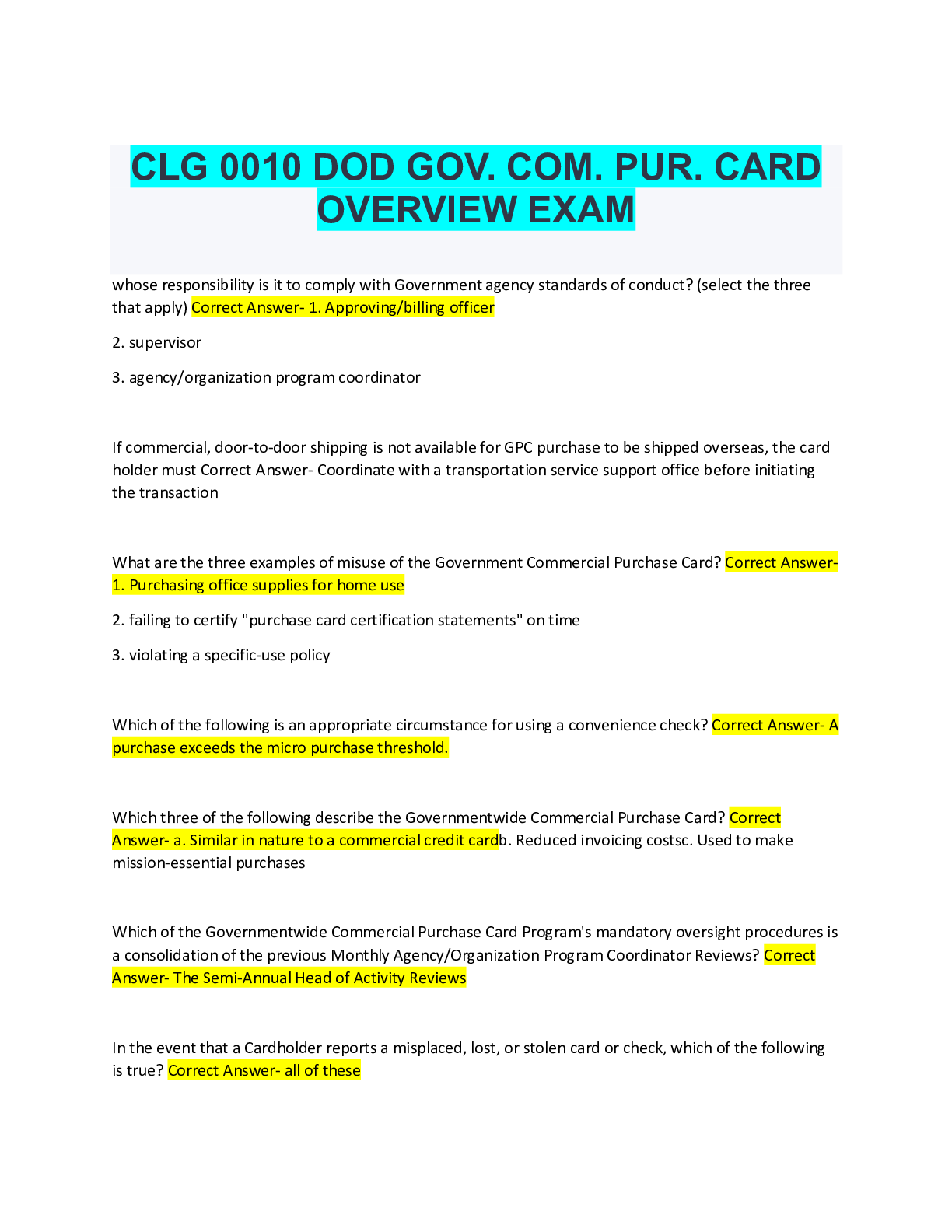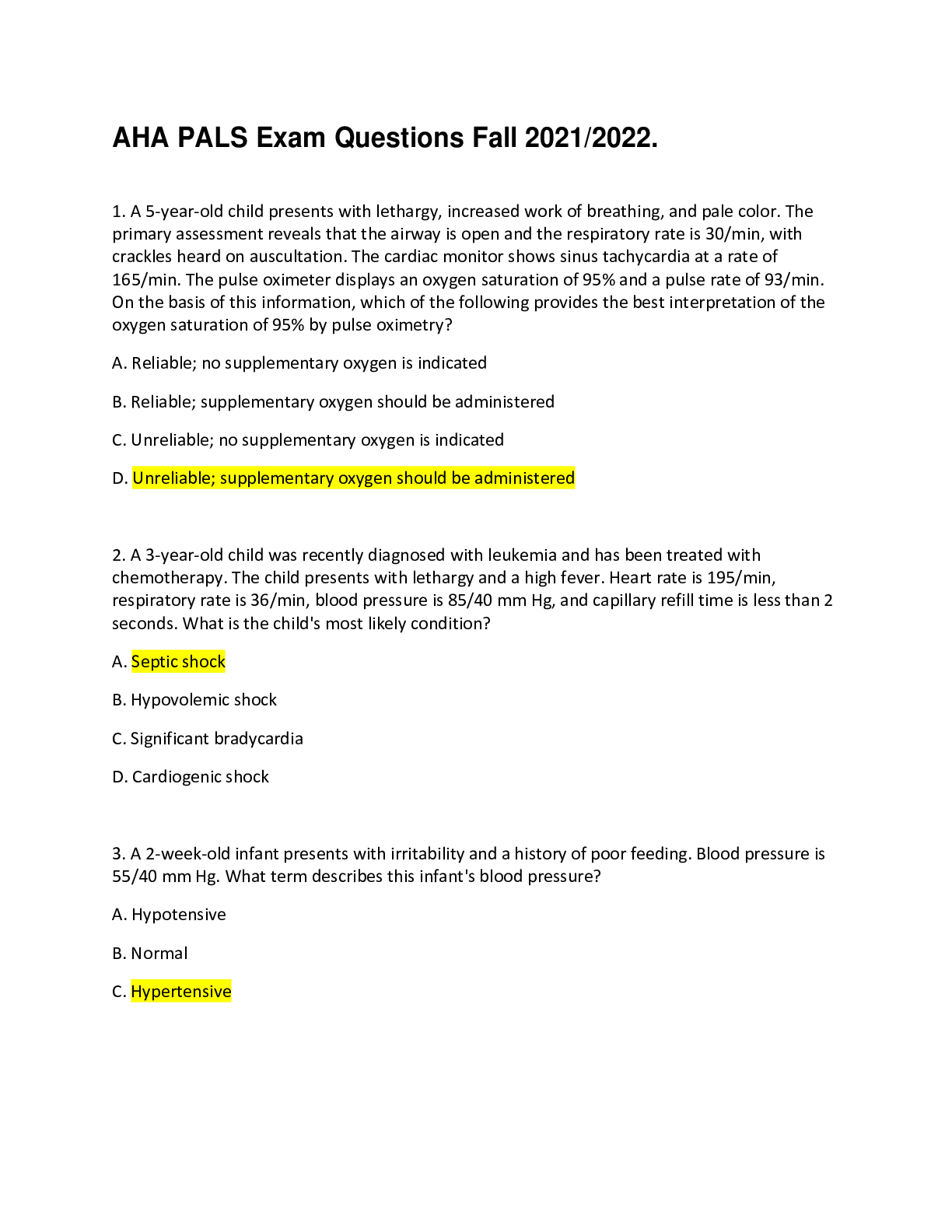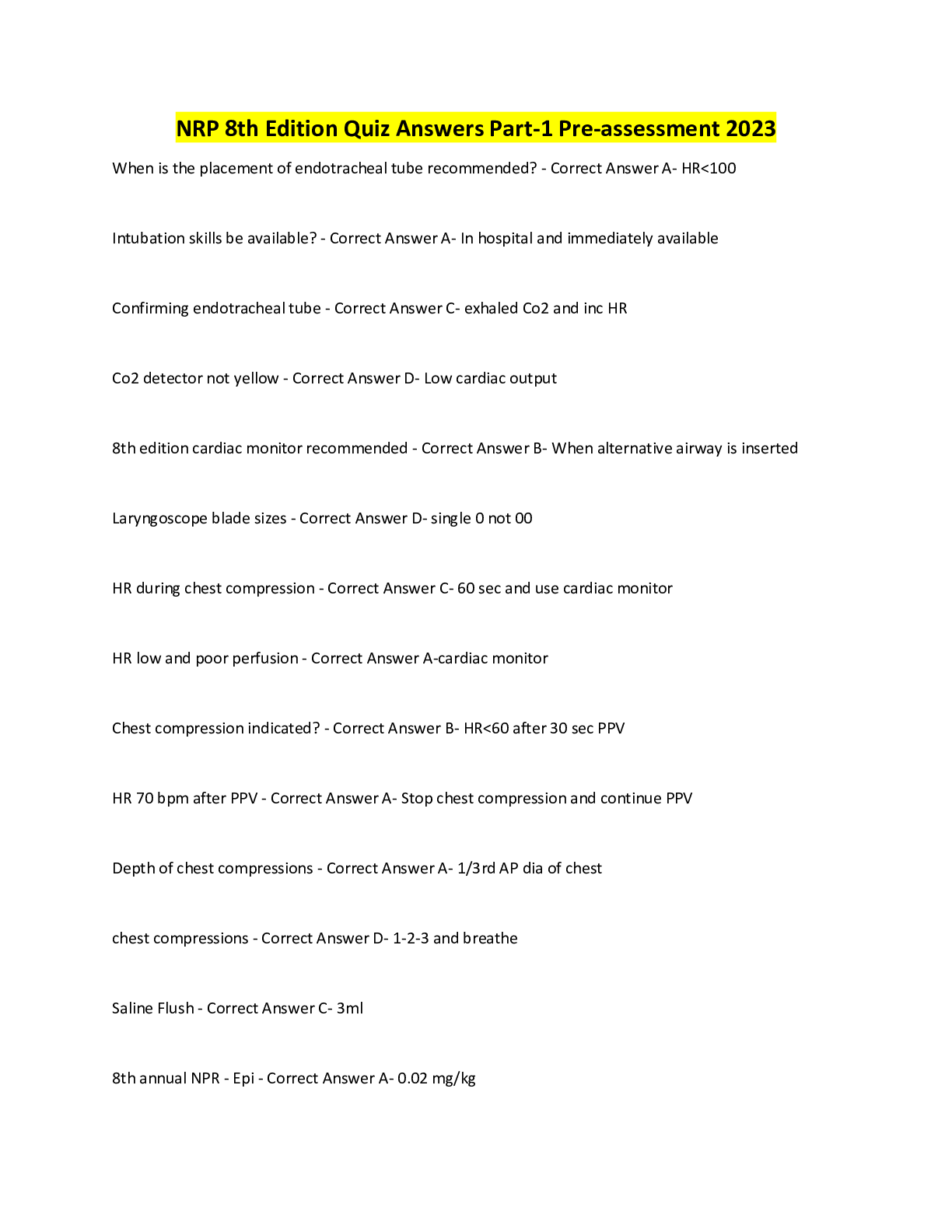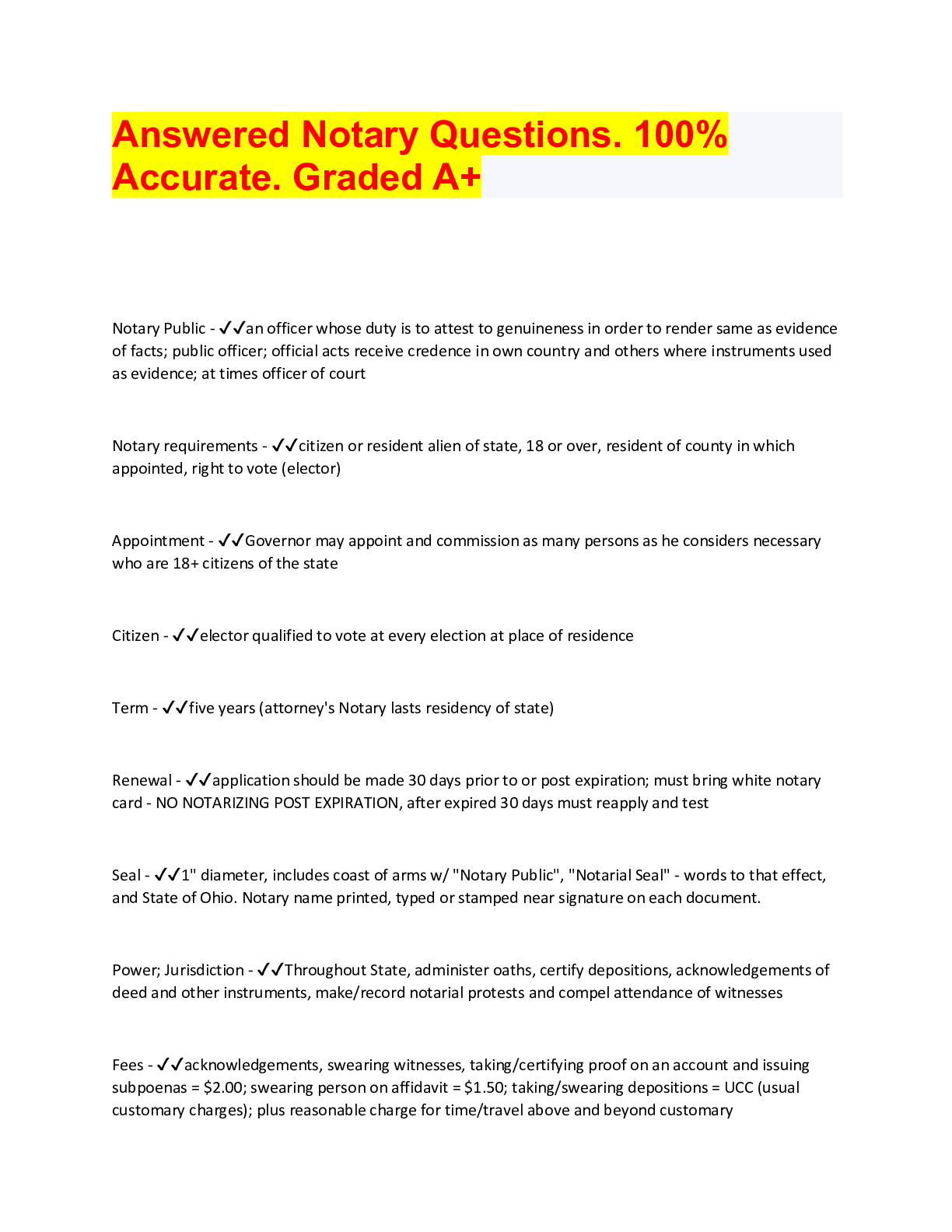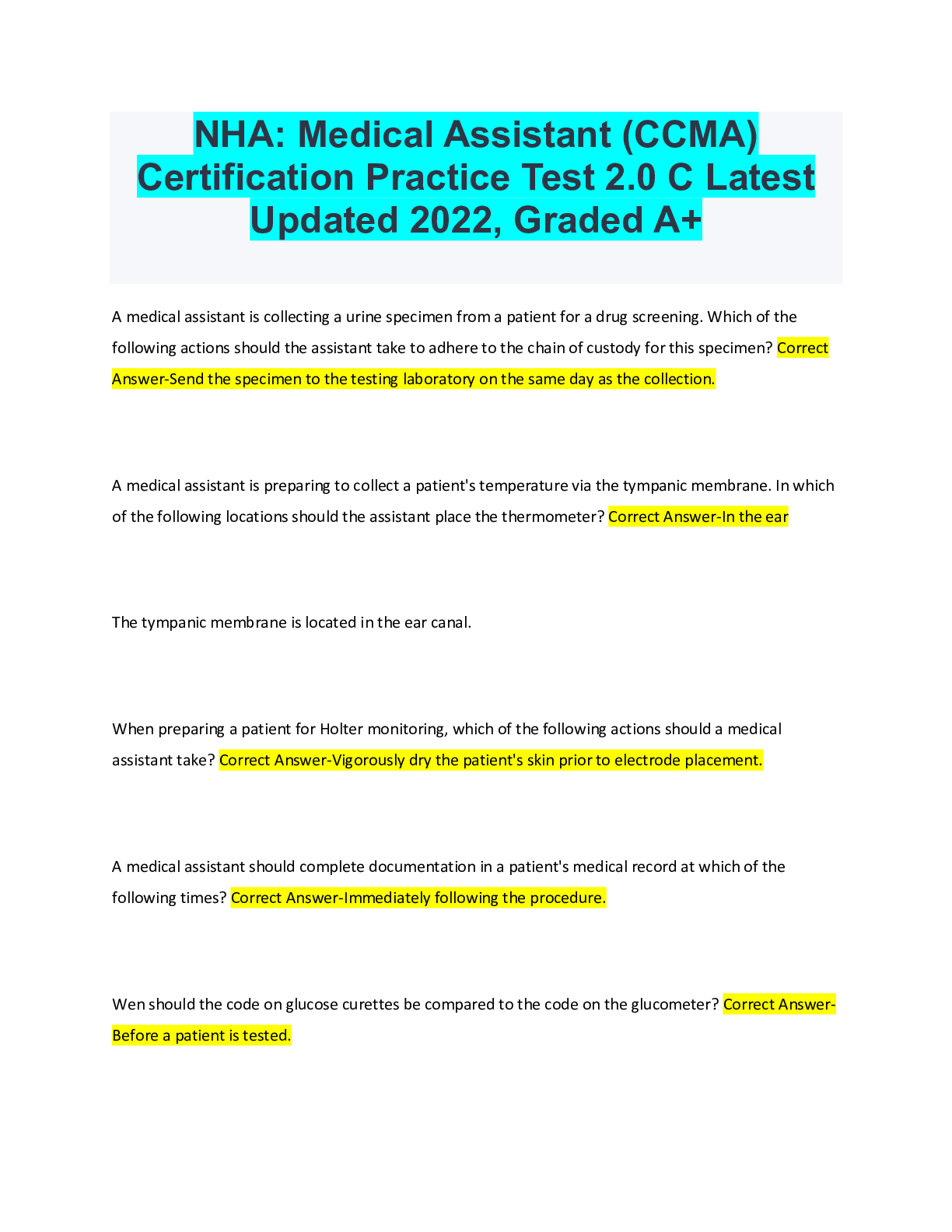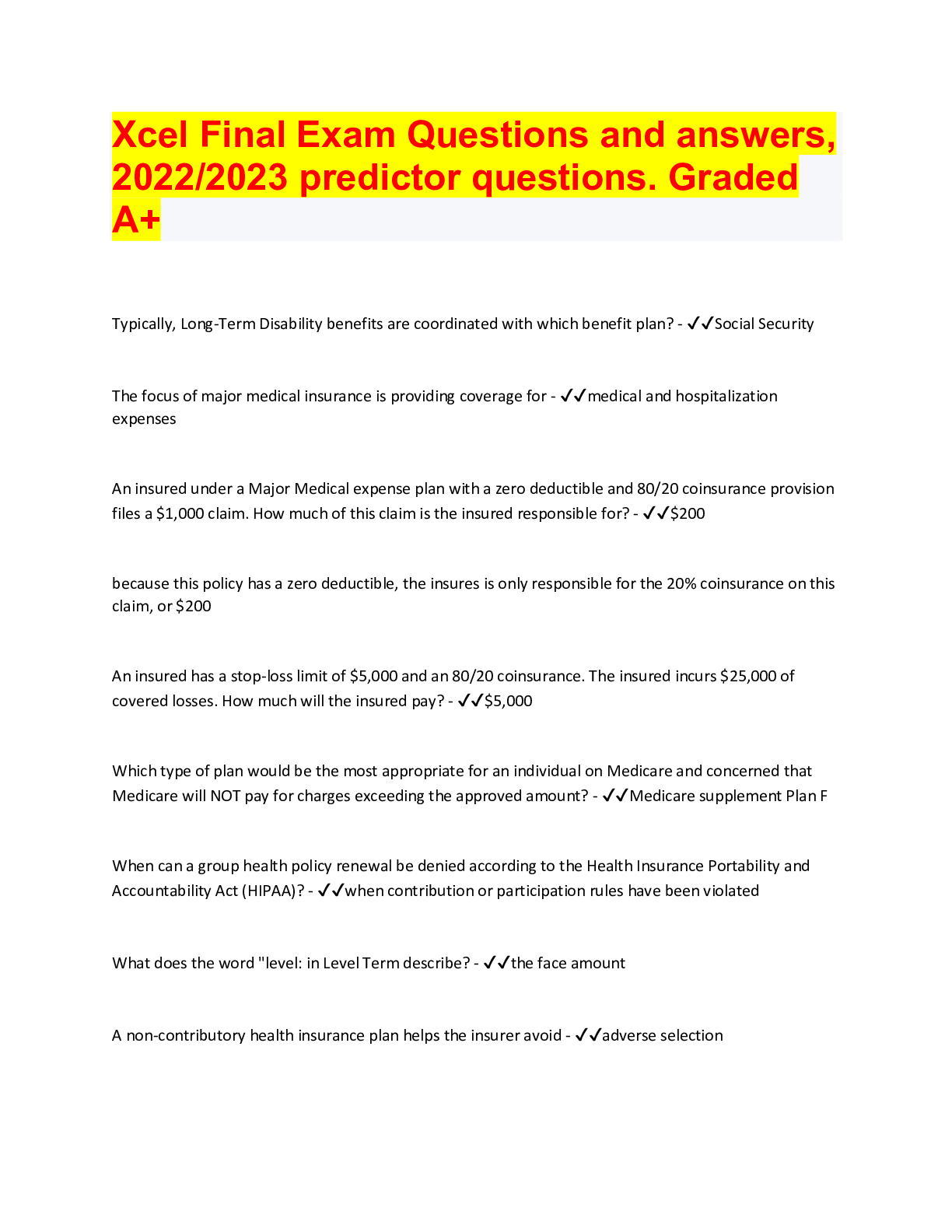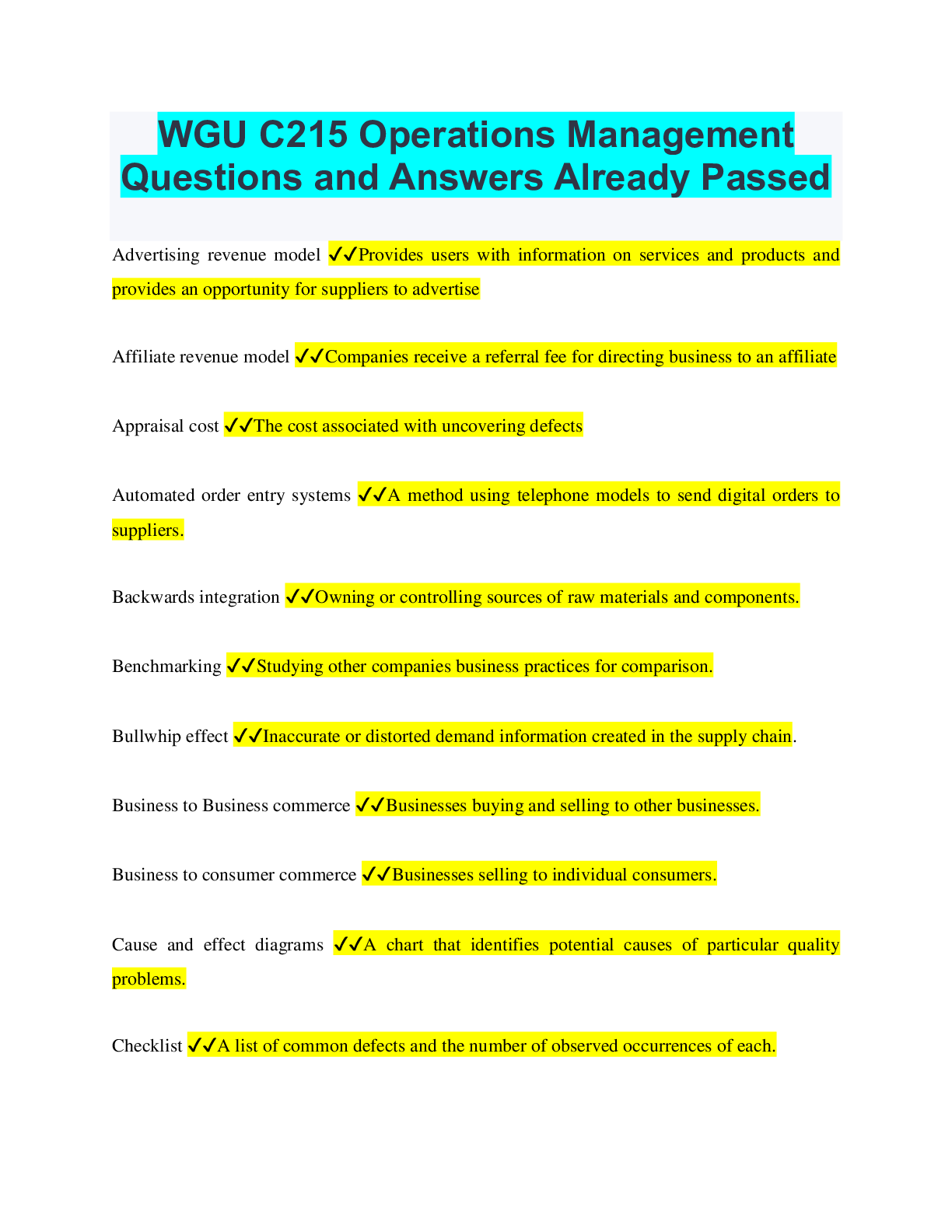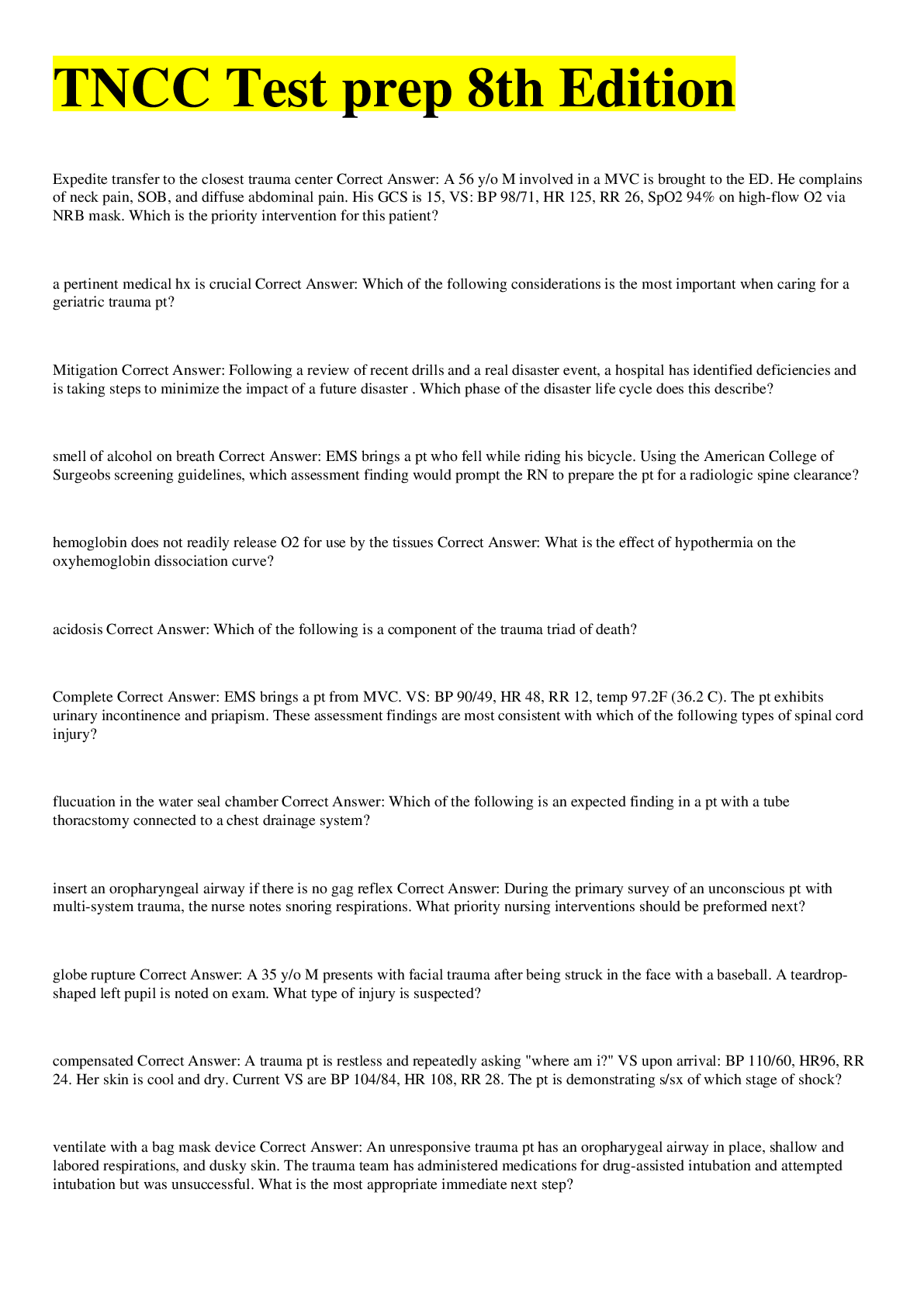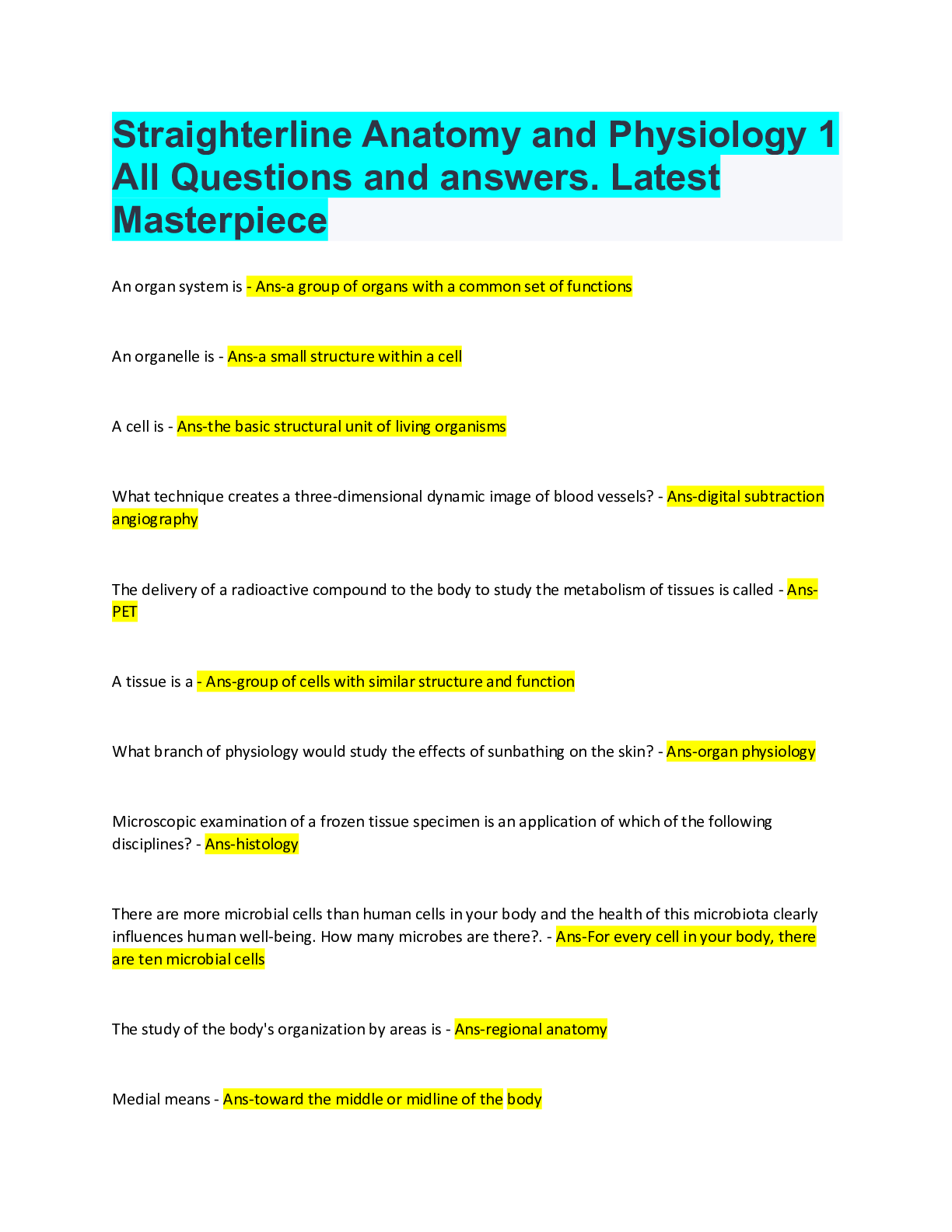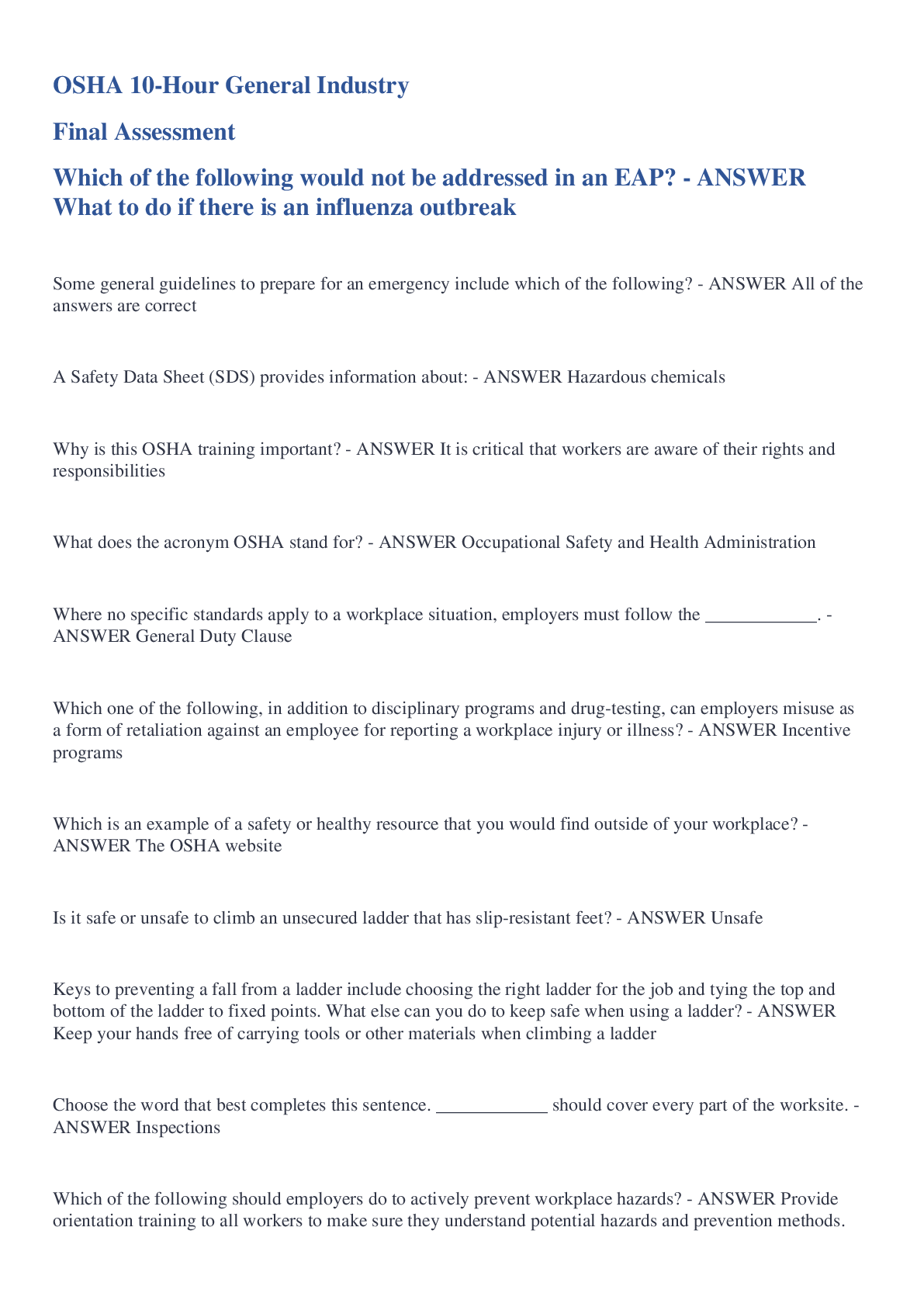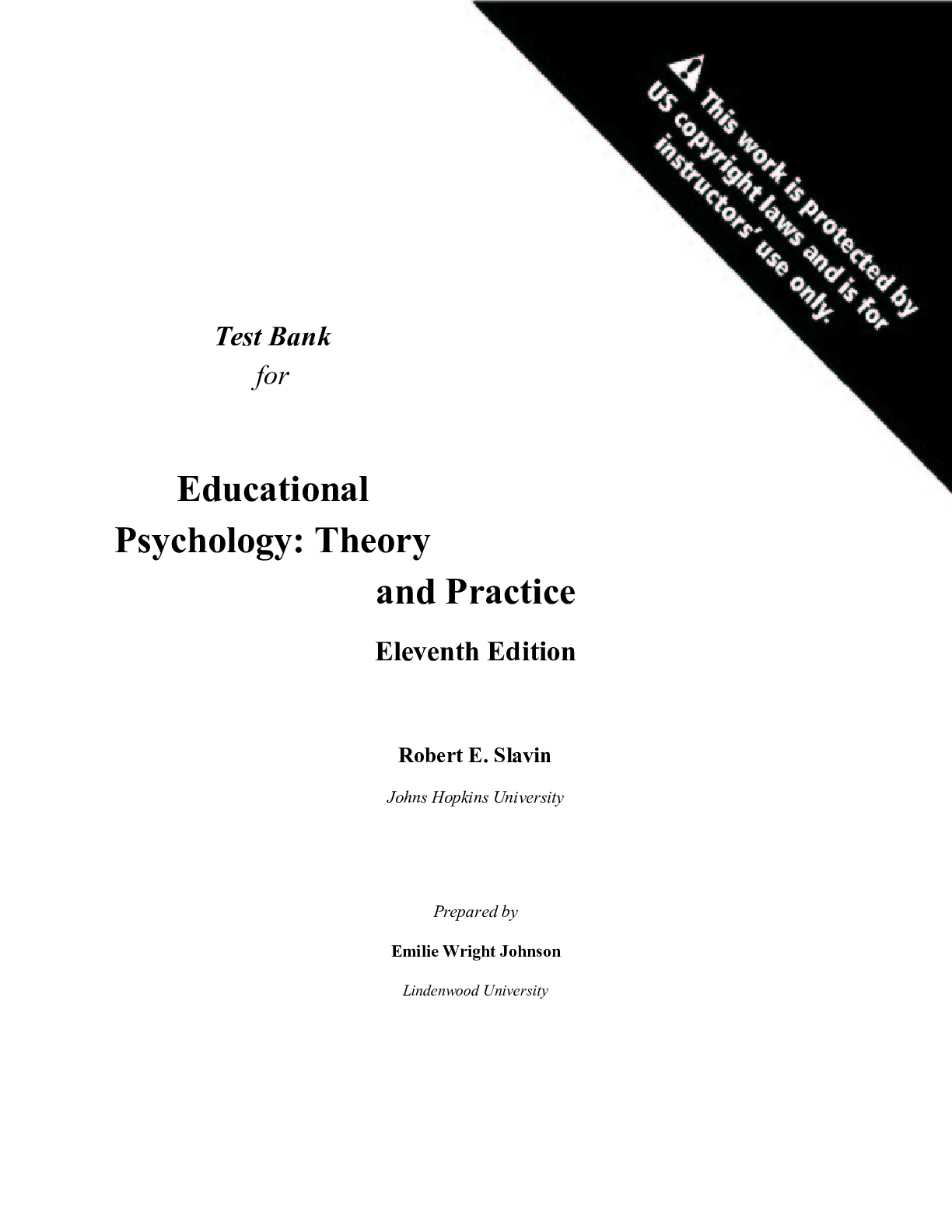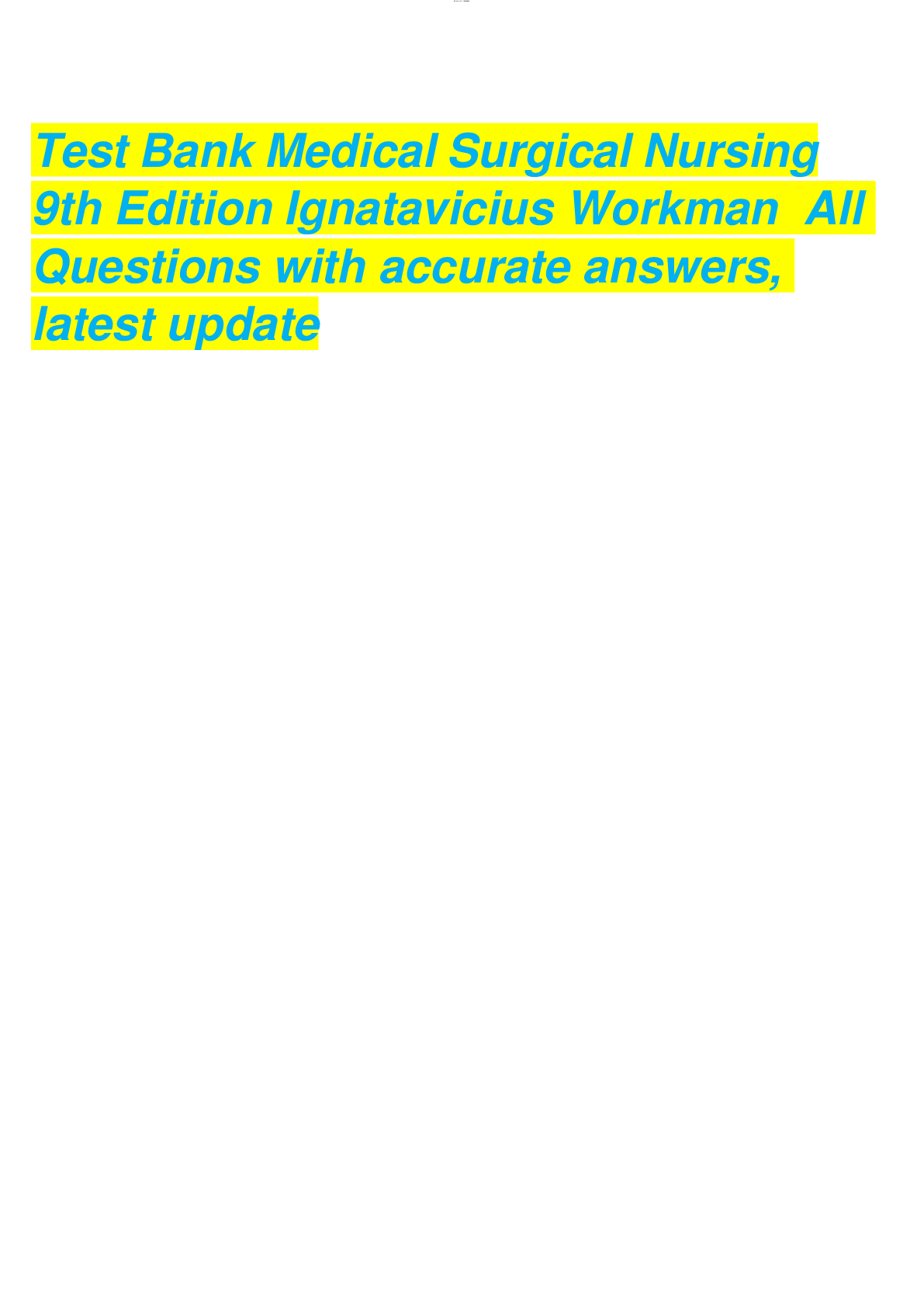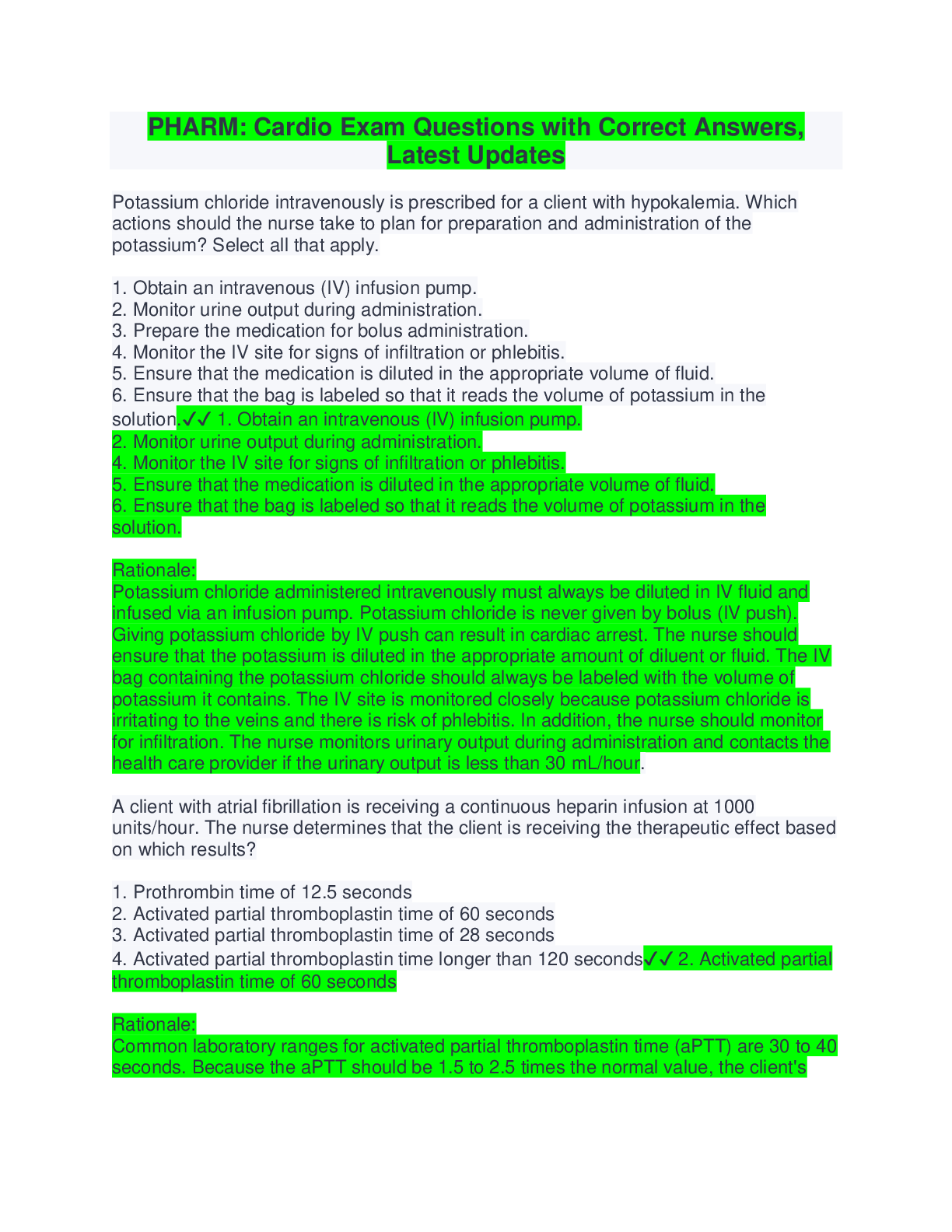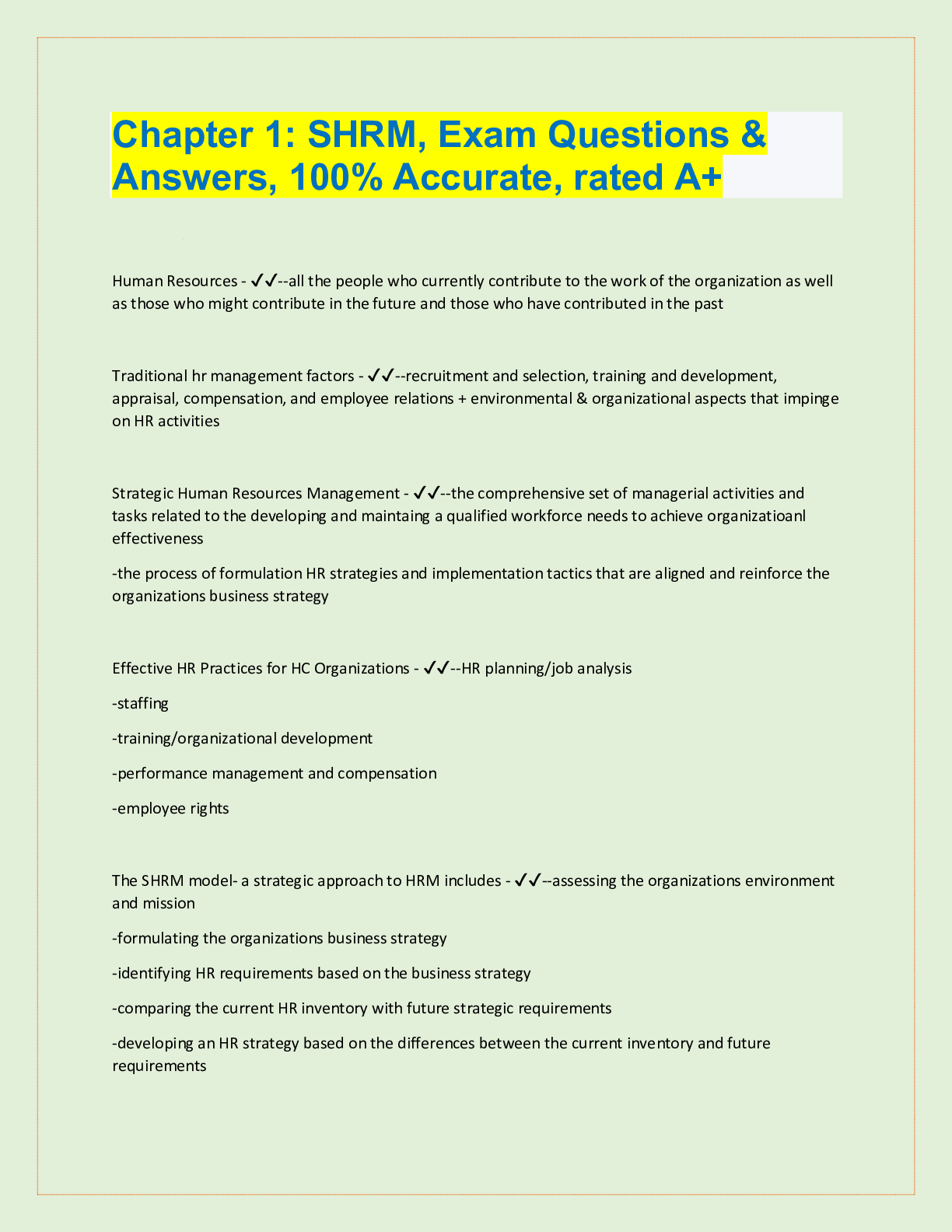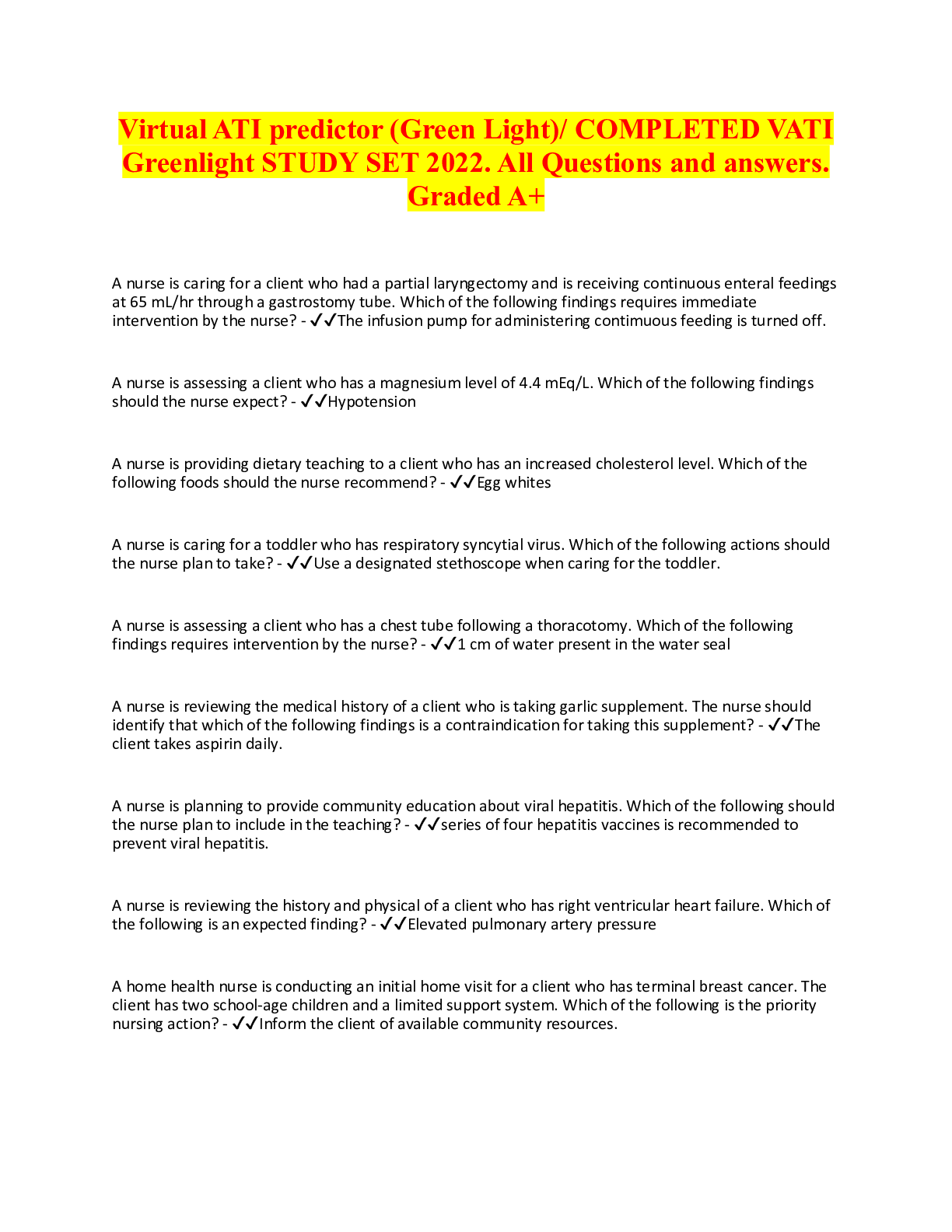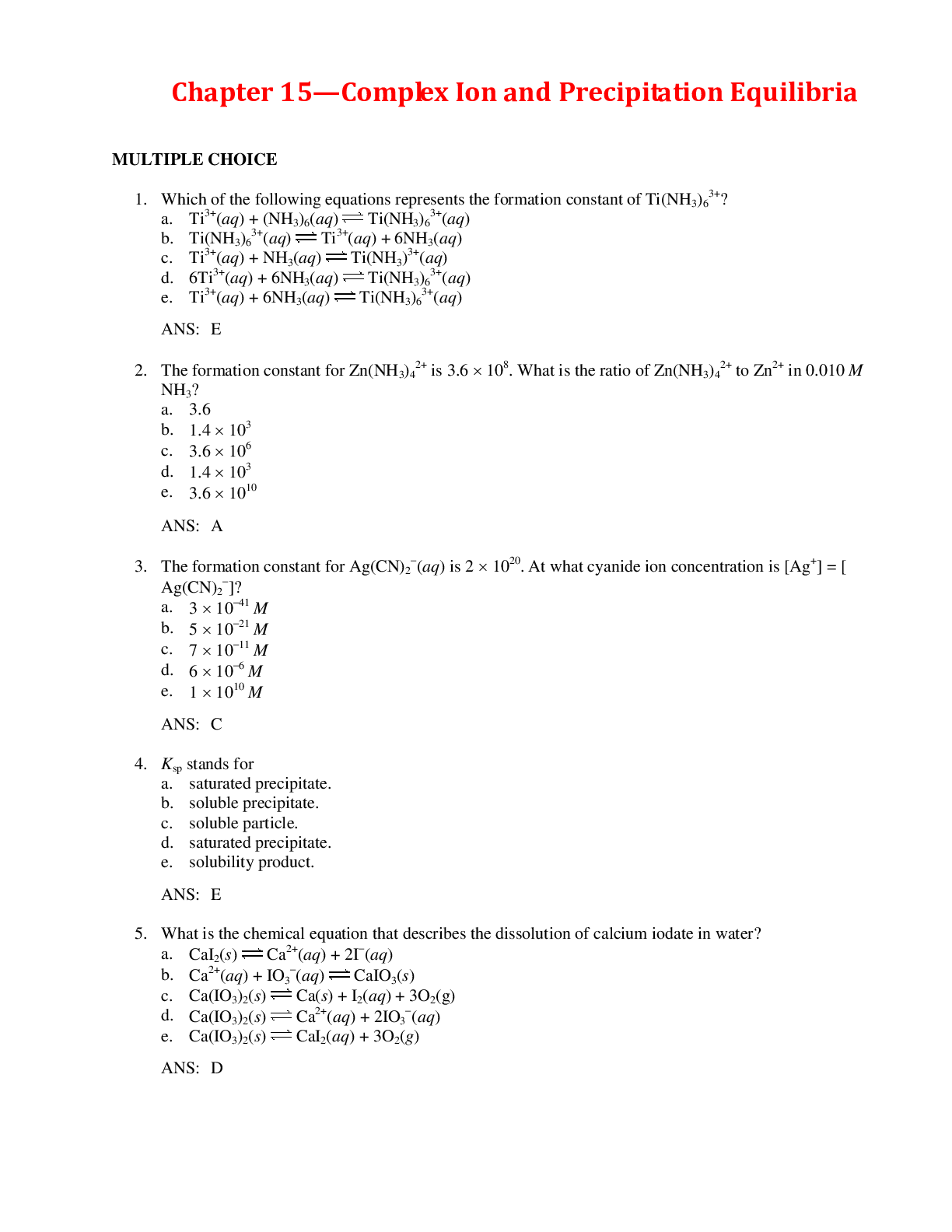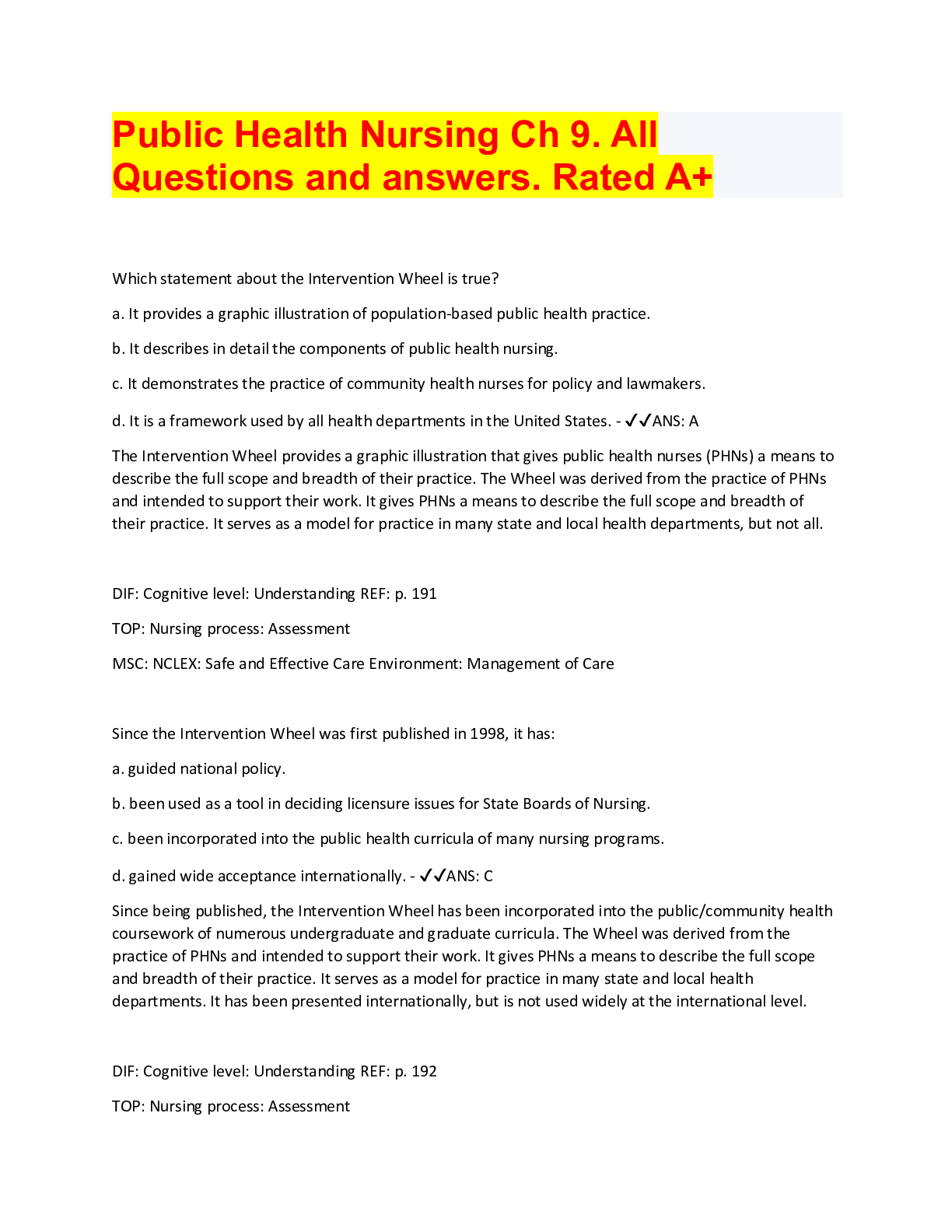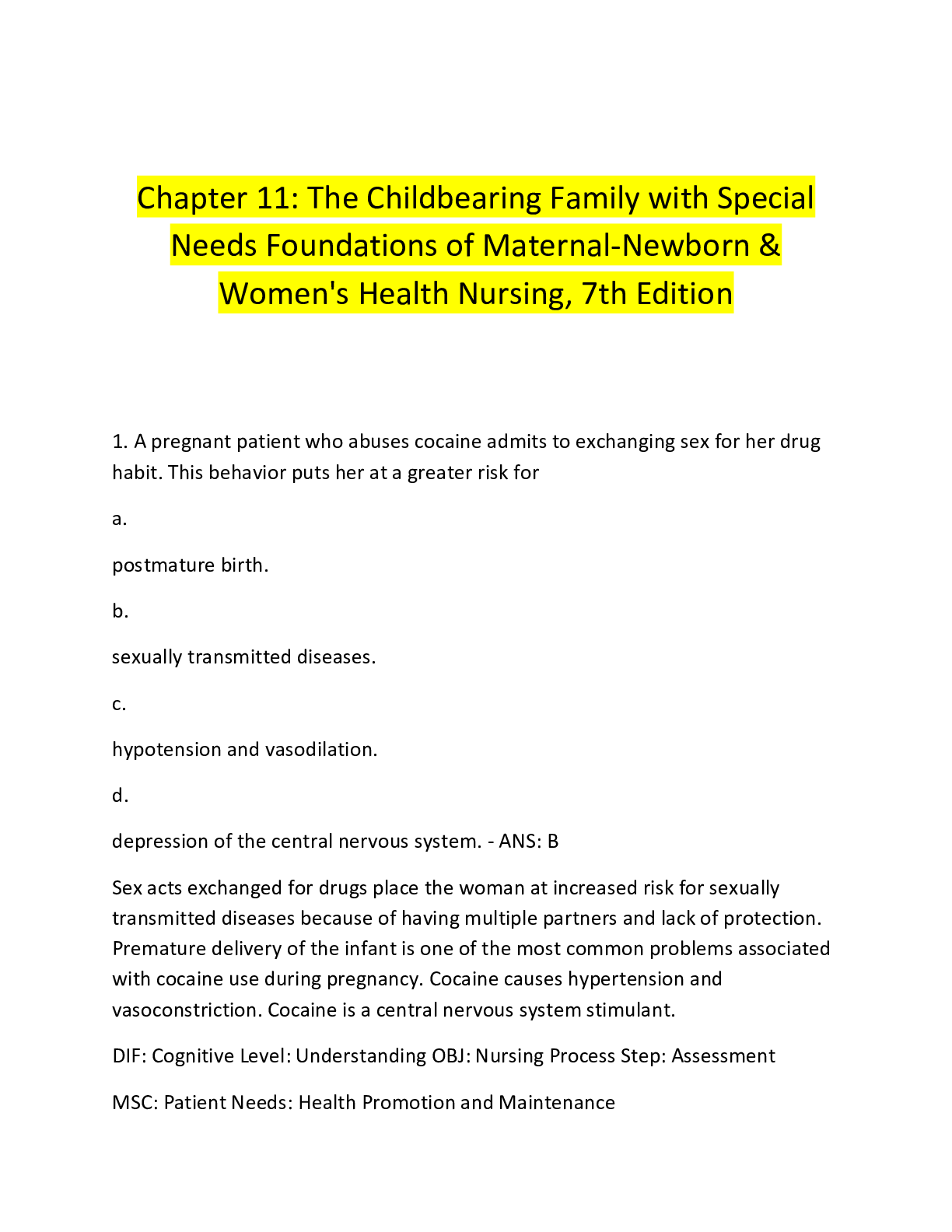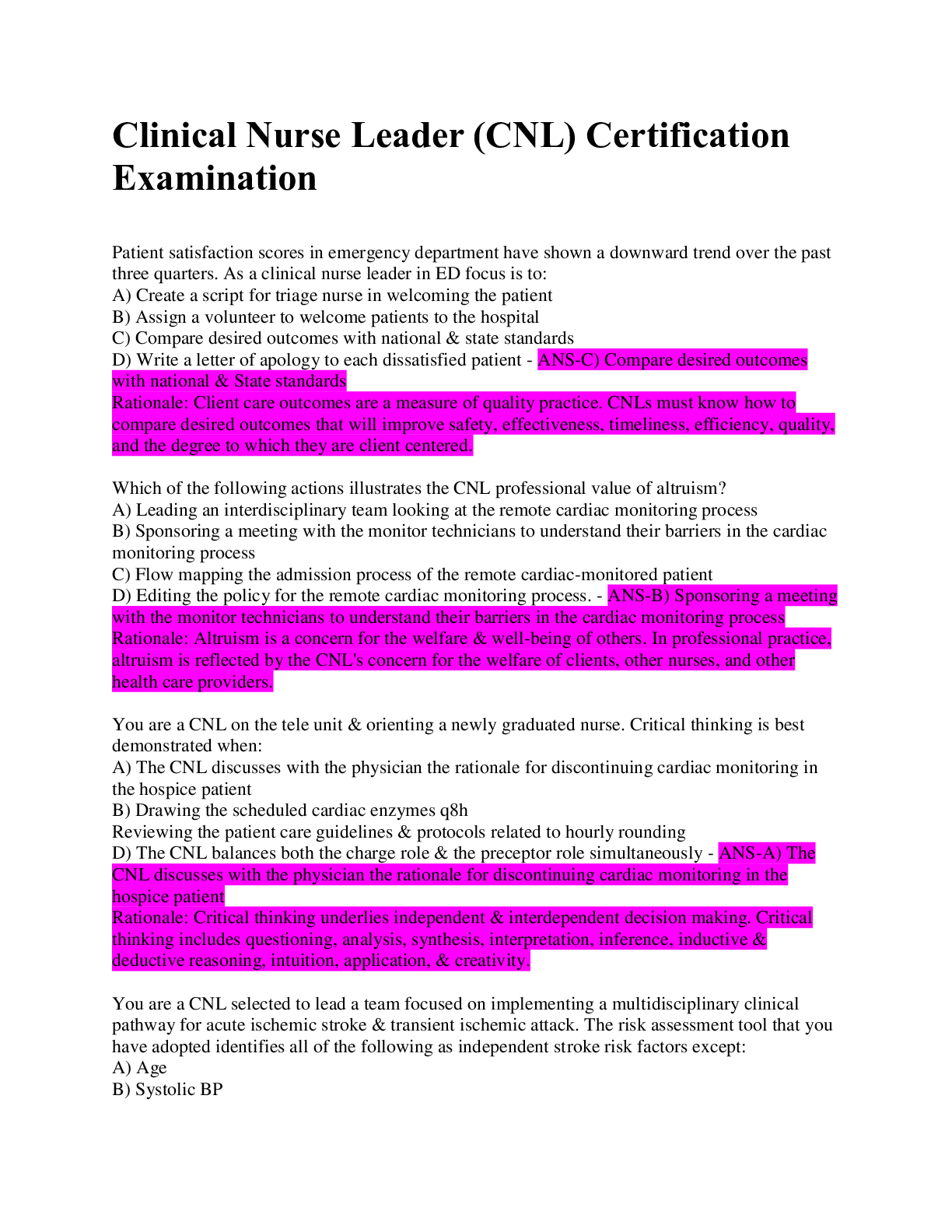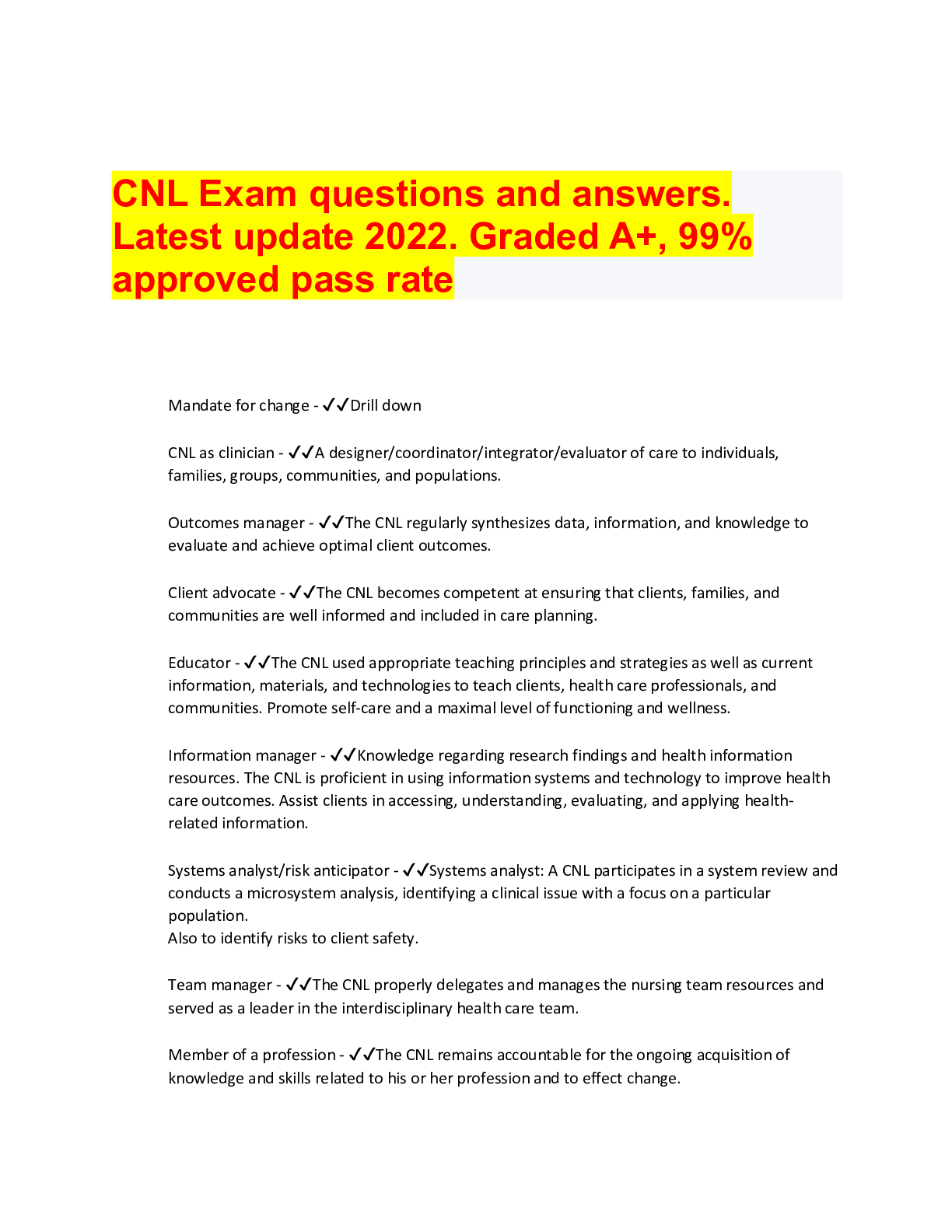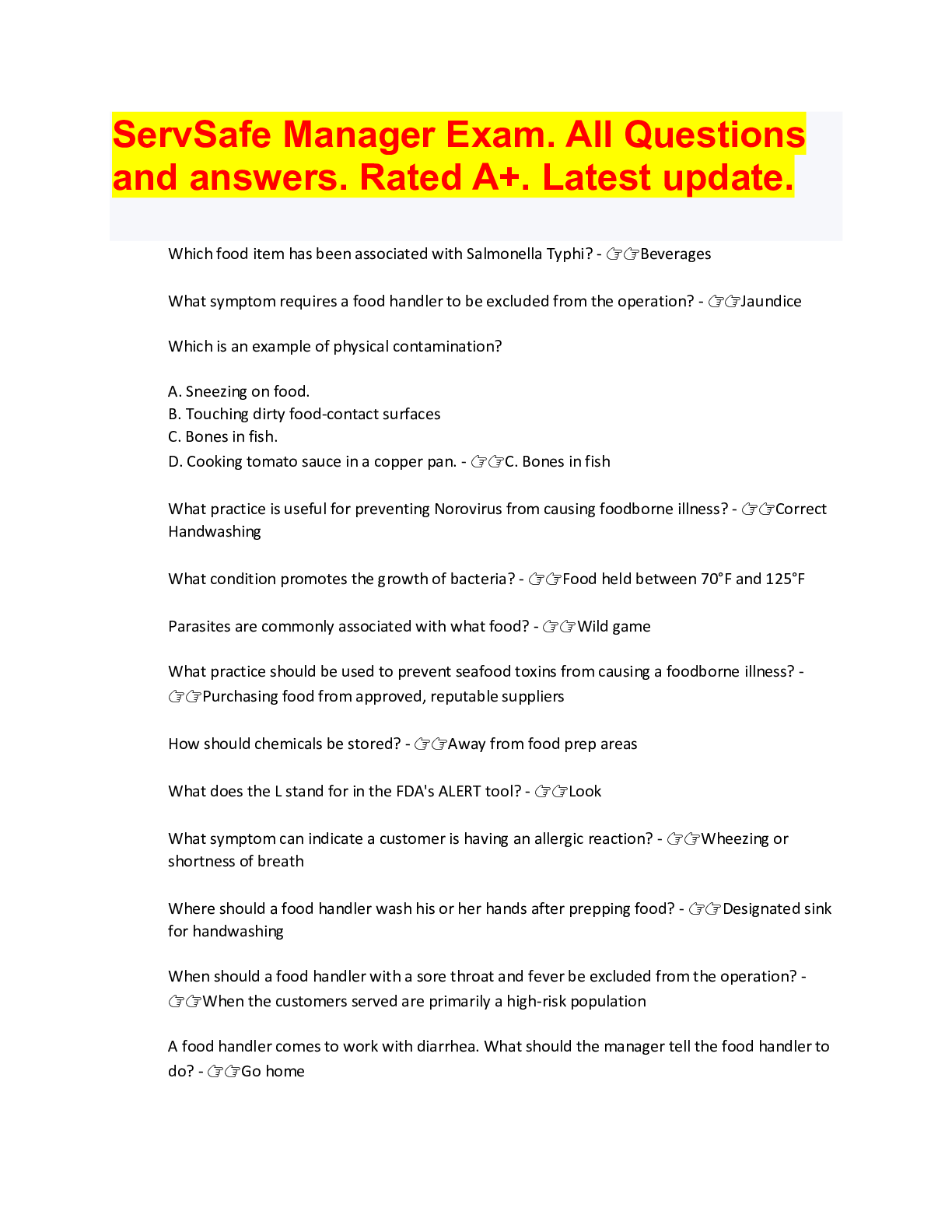*NURSING > QUESTIONS & ANSWERS > TMC Practice Exam B Kettering. All Questions and answers, Latest Update 2022. GRADED A+ (All)
TMC Practice Exam B Kettering. All Questions and answers, Latest Update 2022. GRADED A+
Document Content and Description Below
After a patient undergoes a thoracentesis, the respiratory therapist notes that the obtained pleural fluid is clear with a slight straw color. This fluid is most likely the result of A. empyema. B... . congestive heart failure. C. lung carcinoma. D. hemothorax. - ??B. congestive heart failure. Which of the following would be most important to evaluate for a patient who is entering a smoking cessation program? A. Height B. Smoking history C. Weight D. Diet - ??B. Smoking history The respiratory therapist is calibrating a spirometer and checking the volume with a 3.0 liter super syringe. The volumes recorded are: 2.85 L, 2.8 L, and 2.8 L. Based upon the information obtained which of the following is a correct statement? A. Another syringe needs to be used B. Spirometer is accurate C. The plunger was advanced too slowly D. Spirometer may have a leak - ??D. Spirometer may have a leak Which of the following is an indication for high frequency jet ventilation? A. Bronchopleural fistula B. Wilson Mikity syndrome C. Necrotizing lesion of right lung D. Centrilobular emphysema - ??A. Bronchopleural fistula A 43-year-old female patient has just undergone a total abdominal hysterectomy. The patient arrives in the post anesthesia care unit obtunded with minimal response to painful stimulus. What treatment should the respiratory therapist recommend for this patient? A. Initiate assisted ventilation B. Insert oropharyngeal airway C. Obtain positron emission tomography D. Initiate noninvasive capnography - ??B. Insert oropharyngeal airway A 44 week gestational age infant has just been delivered via C-section and is gasping, grunting, and has tachycardia and tachypnea. At one minute his Apgar score is 4 and at 5 minutes the score is 5. The infant is most likely suffering from A. transient tachypnea of the newborn. B. meconium aspiration. C. bronchopulmonary dysplasia. D. apnea of prematurity. - ??B. meconium aspiration. What is the normal VD/VT ratio for a patient breathing room air? A. 5 - 15% B. 20 - 40% C. 45 - 55% D. 65 - 75% - ??B. 20 - 40% A heat moisture exchanger is indicated for humidification in which of the following situations? A. Mechanical ventilation in a long-term care facility. B. Transport to a tertiary care center. C. Patient with tenacious secretions. D. Delivery of aerosolized bronchodilators. - ??B. Transport to a tertiary care center. All of the following could cause a patient's right-hemidiaphragm to be elevated, EXCEPT A. right lower lobe atelectasis. B. right side hyperlucency, absent vascular markings. C. hepatomegaly. D. right lower lobe consolidation with air bronchograms. - ??B. right side hyperlucency, absent vascular markings A 64-year-old, 70 kg (154 lb) man with severe COPD is receiving independent (differential) lung ventilation following thoracotomy and right lower lobectomy. Which of the following setting combinations would be most appropriate for this patient? A. Right lung 50 mL; left lung 650 mL B. Right lung 150 mL; left lung 550 mL C. Right lung 350 mL; left lung 350 mL D. Right lung 550 mL; left lung 150 mL - ??B. Right lung 150 mL; left lung 550 mL A patient in the intensive care unit has the following hemodynamic measurements: CVP (mm Hg) 5 PAP (mm Hg) 29/8 PCWP (mm Hg) 8 BP (mm Hg) 130/70 Cardiac output (L/min) 5.1 Cardiac index (L/min/m2) 2.7 What is the pulse pressure? A. 15 mm Hg B. 21 mm Hg C. 60 mm Hg D. 90 mm Hg - ??C. 60 mm Hg A 2-year-old child with croup has been intubated for 4 days with a 4 mm ID uncuffed endotracheal tube. Heated aerosol at an FIO2 of 0.30 has been delivered to the patient. The physician asks the respiratory therapist to evaluate the patient for possible extubation. Which of the following would most likely indicate that the patient is ready for extubation? A. The patient is making normal quiet ventilatory efforts. B. A negative sputum culture and sensitivity has been reported. C. The patient's ABG are within normal range. D. Breath sounds are heard around the tube on auscultation. - ??D. Breath sounds are heard around the tube on auscultation. A patient is seen in the Emergency Department for complaints of nausea and vomiting. A nasogastric tube has been inserted and the patient is started on lasix. Which of the following should the respiratory therapist monitor? A. Cardiac enzymes B. Serum electrolytes C. Arterial blood gases D. Cell hydration level - ??B. Serum electrolytes While instructing a patient prior to a vital capacity maneuver, the respiratory therapist should direct the patient to A. exhale to residual volume and inhale to inspiratory capacity. B. inhale to total lung capacity then exhale to residual volume. C. exhale normally then inhale to total lung capacity. D. inhale normally then exhale to functional residual capacity. - ??B. inhale to total lung capacity then exhale to residual volume. A patient involved in an automobile accident is brought to the ED with tachypnea, tracheal deviation to the right, splinting, asymmetrical chest movement, and decreased breath sounds on the left side. The respiratory therapist should initially A. insert a chest tube. B. administer 100% oxygen via mask. C. perform endotracheal intubation. D. initiate non-invasive positive pressure ventilation. - ??B. administer 100% oxygen via mask. A 77-year-old male patient is admitted to the emergency room with shortness of breath, fine basilar crackles, +2 pitting edema and a chest radiogram with a butterfly pattern. These results are most consistent with which of the following? A. Pulmonary edema B. Pulmonary interstitial emphysema C. Pneumothorax D. Emphysema - ??A. Pulmonary edema Which of the following formulas will determine the total flow being delivered to a patient with a 28% venturi mask running at 6 L/min? A. total flow = 6 x 2 B. total flow = 6 x 4 C. total flow = 6 x 5 D. total flow = 6 x 11 - ??D. total flow = 6 x 11 Fine crepitant crackles are most commonly associated with which of the following conditions? A. Bronchitis B. Pulmonary edema C. Pneumonia D. Foreign body aspiration - ??B. Pulmonary edema A patient with end-stage pulmonary fibrosis is receiving oxygen at 2 L/min via a transtracheal oxygen catheter. The patient experiences an increased work of breathing and shortness of breath. The respiratory therapist should A. manually ventilate the patient with a resuscitation bag. B. increase the flow to the transtracheal catheter to 6 L/min. C. evaluate the SpO2 with a pulse oximeter. D. flush the transtracheal device with isotonic saline. - ??D. flush the transtracheal device with isotonic saline. During bedside monitoring the respiratory therapist notices a dampened waveform on the arterial line graphic. To restore the graphic to normal, the therapist should first A. verify the position of the transducer. B. check the transducer dome for air bubbles. C. flush the catheter with heparin solution. D. attempt to draw blood from the arterial line. - ??B. check the transducer dome for air bubbles. An optimal PEEP study is initiated on a patient receiving mechanical ventilation. The respiratory therapist first places the patient on a PEEP of 10 cm H2O for 20 minutes with no adverse effects. The PEEP is increased to 15 cm H2O and the patient's heart rate rises significantly with a severe fall in the blood pressure. Based upon the above information, the therapist should conclude that the patient is suffering from A. peripheral vasoconstriction. B. hypovolemia. C. increased venous return. D. increased SVR - ??B. hypovolemia. A post-operative thoracotomy patient is receiving incentive spirometry therapy Q2H. Breath sounds are diminished in the bases of the lungs with scattered crackles. The patient's inspiratory capacity has decreased over the past 2 days. A chest radiograph indicates thin-layered basilar densities. Which of the following has most likely occurred? A. Atelectasis B. Pneumonia C. Pulmonary edema D. Consolidation - ??A. Atelectasis A patient is in full cardiopulmonary arrest and after several attempts, the patient is orally intubated with a size 7 mm ID endotracheal tube. The nurse is unable to establish IV access. The ECG monitor shows sinus bradycardia. Which of the following drugs should be administered through the endotracheal tube? A. Lidocaine B. Epinephrine C. Atropine D. Dobutamine - ??C. Atropine The results of a patient's spirometry are recorded as follows: Predicted Observed FVC (L) 3.5 2.1 FEV1 (L) 2.7 2.6 FRC (L) 2.5 1.7 TLC (L) 5.6 4.2 These results are indicative of A. normal lung function. B. sarcoidosis. C. acute bronchitis. D. cystic fibrosis. - ??B. sarcoidosis. The respiratory therapist is in charge of transporting a patient with multiple trauma to a regional trauma center in a fixed wing aircraft. Which of the following should the therapist be most concerned about during the transport? A. Tissue oxygenation B. Pneumothorax C. Pulmonary embolus D. Humidification of the inspired gas - ??A. Tissue oxygenation Transcutaneous monitoring of PO2 values will correlate well with arterial blood gas PO2 values in which of the following situations? 1. Hypotension 2. Hypothermia 3. Pneumonia A. 1 only B. 3 only C. 1 and 2 only D. 2 and 3 only - ??B. 3 only A patient is being ventilated in the intensive care unit. The following data is obtained: Mode VC, SIMV Mandatory rate 12 b/min Total rate 18 b/min VT 800 mL FIO2 0.60 PIP 31 cm H2O PEEP 10 cm H2O pH 7.41 PaCO2 40 torr PaO2 95 torr SaO2 96% HCO3- 23 mEq/L BE +1 mEq/L PECO2 30 torr Hb 15 g/dL What should the respiratory therapist report as the VD/VT ratio? A. 15% B. 25% C. 40% D. 50% - ??B. 25% What is the air-to-oxygen ratio for an air entrainment device delivering 60% oxygen? A. 1:1 B. 3:1 C. 4:1 D. 10:1 - ??A. 1:1 Following surgery to correct an abdominal aortic aneurysm, a 54-year-old female patient suddenly develops intense substernal chest pain with severe dyspnea. The pain does not appear to be aggravated by her respirations. Auscultation reveals bilateral, basilar, moist, crepitant rales. The patient appears pale, cold and clammy. Which of the following should the respiratory therapist recommend for initial assessment of this patient? A. Serum electrolytes B. Chest x-ray C. Complete blood cell count D. Electrocardiograph - ??D. Electrocardiograph [Show More]
Last updated: 1 year ago
Preview 1 out of 56 pages
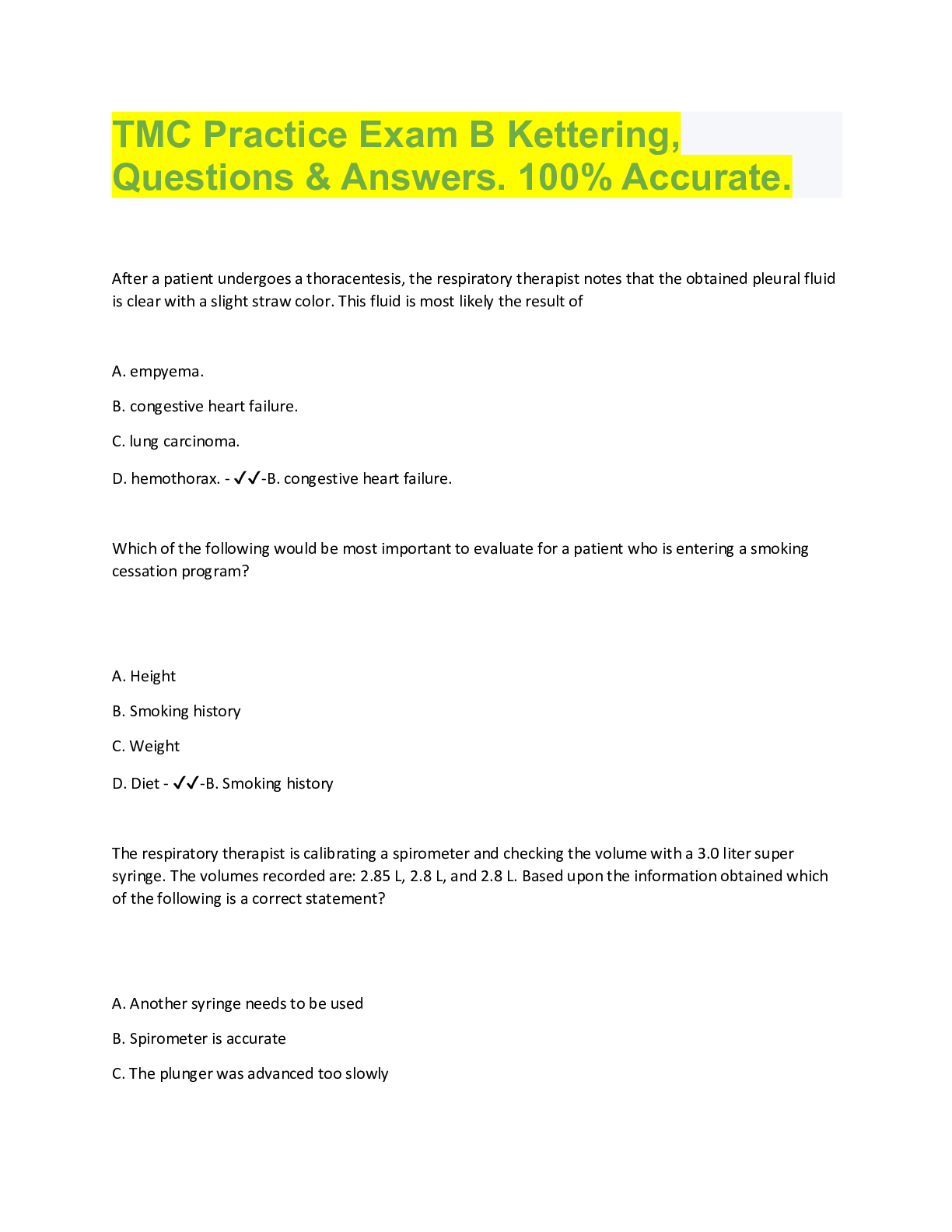
Also available in bundle (2)
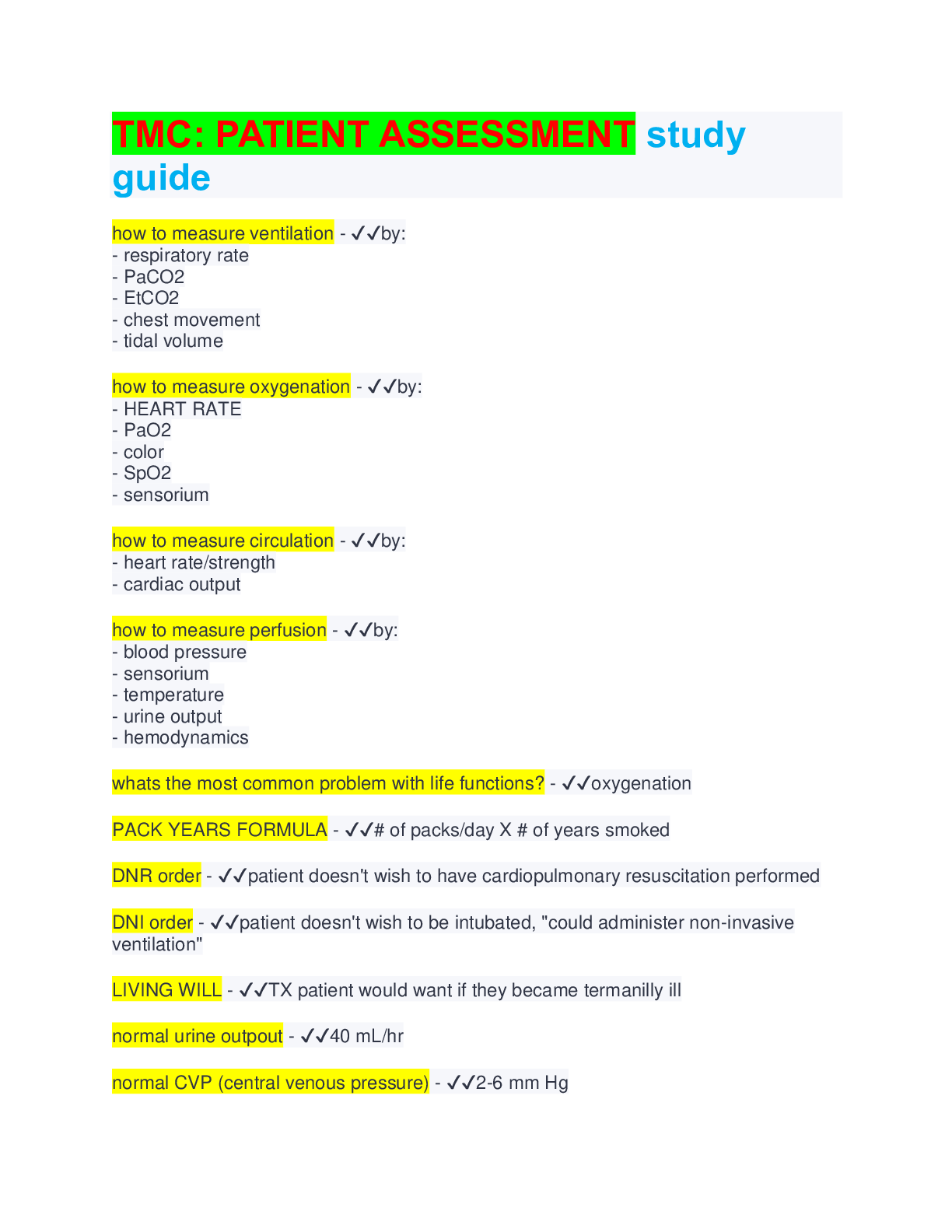
All TMC practice questions papers with answers. Bank questions. Download to score A
Most sought TMC revision kits. Guaranteed comprehension/ GRADE A+
By bundleHub Solution guider 1 year ago
$35
8
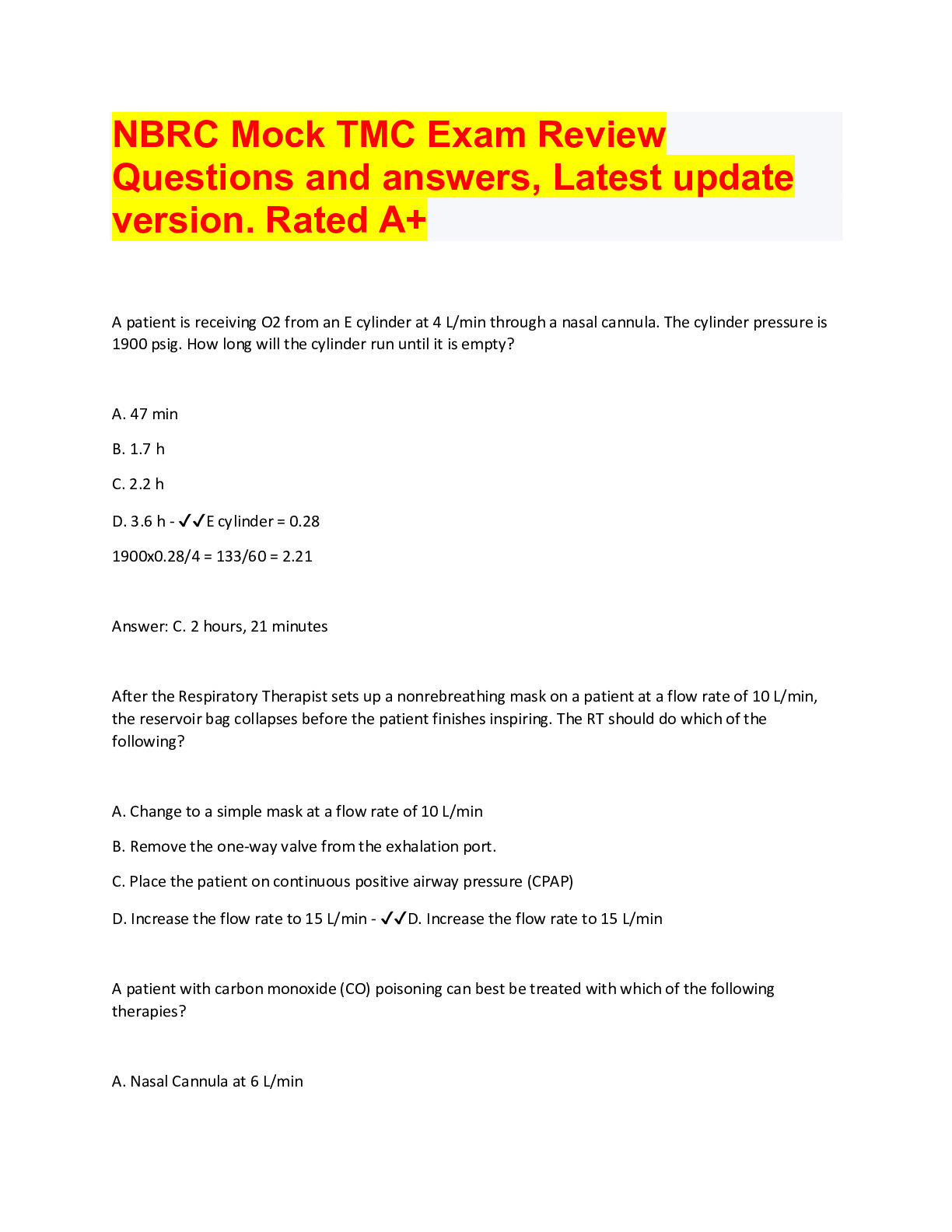
TMC EXAM BUNDLE, QUESTIONS WITH ACCURATE ANSWERS
ALL VERSIONS OF TMC EXAM PAPERS, BUNDLED QUESTIONS WITH ANSWERS, LATEST UPDATES
By bundleHub Solution guider 1 year ago
$38
16
Reviews( 0 )
Document information
Connected school, study & course
About the document
Uploaded On
Aug 07, 2022
Number of pages
56
Written in
Additional information
This document has been written for:
Uploaded
Aug 07, 2022
Downloads
0
Views
98




